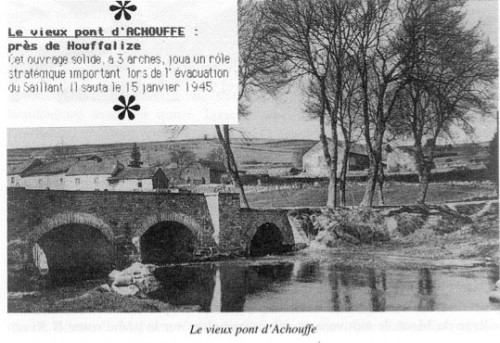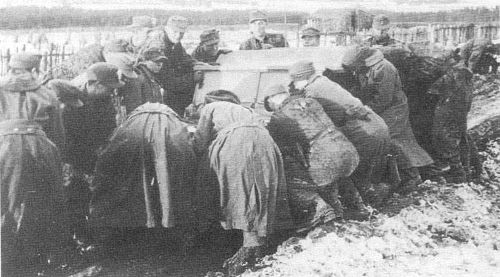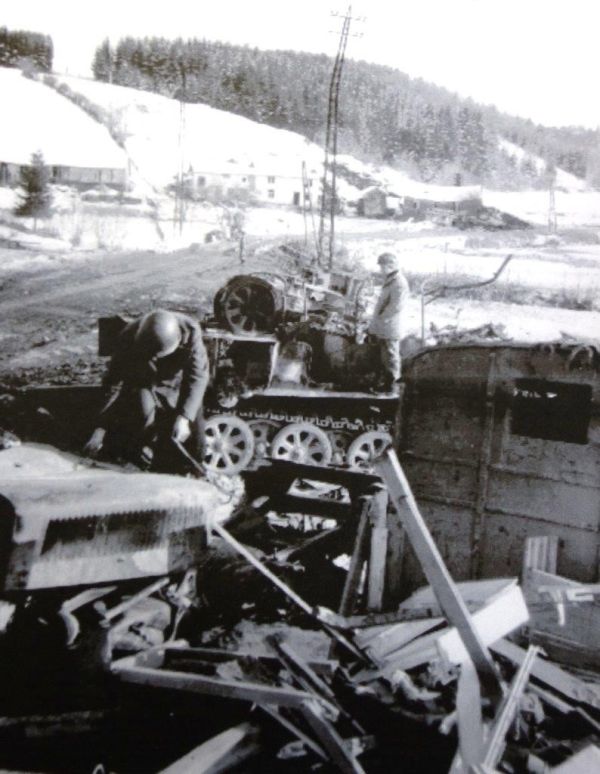Battle of Achouffe, 13-15 January 1945
Preface
On 16 December 1944 the Germans launched a massive attack on the allied troops in the Ardennes, a campaign which is commonly known as The Battle of the Bulge. Their aim was to split the allied armies and capture the port city of Antwerp. From 16 till 20 December German troops advanced towards Stavelot, Sankt-Vith, Houffalize and Bastogne. The allied forces managed to repel the attack. The German salient in the Ardennes was eliminated when the American 2nd and 11th Armored Divisions re-established contact near Houffalize on 16 January. By then the Germans had already started to evacuate the salient. One of these evacuation routes led trough the village of Achouffe, nowadays well-known because of the presence of a brewery.
The strategic importance of Achouffe
Achouffe is a small village in the municipality of Houffalize, in Wallonia, Belgium. When the Germans launched their offensive campaign on 16 December 1944, the area around Houffalize bore the brunt of the attack by the 5. Panzerarmee. When the offensive failed, German high command realized that the advance of the allied forces was inevitable and gave the order for a retreat. The Germans tried to evacuate as many troops and equipment as possible. Some groups received the order to provide defensive cover. Combat units, supported by tanks, were assembled to defend the territory across which the retreat was to take place. Lengthy columns of all sorts of vehicles moved towards one of the last places which offered a passage eastwards. One of these evacuation routes led trough the village of Achouffe, initially a place of no importance on all military maps. A position of strategic importance was the bridge, which crossed the Ruisseau de Martin-Moulin, an affluent of the Ourthe River.
The roads leading to Achouffe were icy and snow covered. Working parties were hastily deployed to spread grit on the roads. Vehicles which had broken down or crashed had to be repaired and hauled away. The allied air forces were unable to intervene due to bad weather. All available artillery was deployed in defence of the insignificant but now strategically important bridge at Achouffe. Disjointed combat units leaving the Bulge via Achouffe chose the shortest route back to Germany. The military convoys began the steep climb towards the village of Mont, which led to the N30, and eventually to the N827 near Aux Chéras. They avoided going through Houffalize which was heavily targeted by the allies.
The battle for the bridge
On the 14th of January, Oberstleutnant Helmut Zander of the 60. Panzergrenadier-Regiment - part of the 116. Panzer-Division - was given the responsibility of defending the bridge at Achouffe and blowing it up at the last possible moment. The next day a strong American force advanced towards Mont and Achouffe. Around 11 o'clock Task Force "A" of the 66th Armoured Regiment arrived in Achouffe. The last remaining troops of the German rear-guard blew up the old bridge and retreated. The American engineer corps had repaired the crossing by the end of the afternoon using 13 meter long rails. The German defence forces had used up their meagre resources to enable a maximum of troops to make their retreat. The remains of four tank divisions and combat units managed to escape through the bottleneck of Achouffe and avoided being trapped in Houffalize.
Mr. Yvon Delacolette, born and raised in the area, was 10 years old in January 1945. He remembers the battles between American and German troops and tanks between 13 and 15 January 1945. He recalls that around 200 frozen bodies of German soldiers were removed from the battlefield and taken to the German cemetery for burial. The American casualties were evacuated and therefore it is unknown how many allied soldiers lost their lives in the unknown battle. The only known American casualty is Major Joe C. Earley. He was a fighter pilot from the 389th Fighter Squadron, 366th Fighter Group. His P-47 Thunderbolt crashed in Achouffe at 12:40 hours on 13 January. He was shot down while flying at low altitude to identify enemy vehicles in the area. He is buried at the Luxembourg American Cemetery.
Definitielijst
- offensive
- Attack on a smaller or larger scale.
- Regiment
- Part of a division. A division divided into a number of regiments. In the army traditionally the name of the major organised unit of one type of weapon.
- Squadron
- A military unit in the Belgian navy usually six to eight small ships operating together under one command. The smallest military unit in the Dutch air force of about 350 men. In most countries is the designation of a military unit thesize of a company. It is either an independent unit, such as a battery, or part of a bigger Calvary unit. In the air force it is the designation of a unit of aircrafts.
Images
Information
- Published by:
- Pieter Schlebaum
- Published on:
- 11-03-2016
- Last edit on:
- 30-09-2024
- Feedback?
- Send it!








